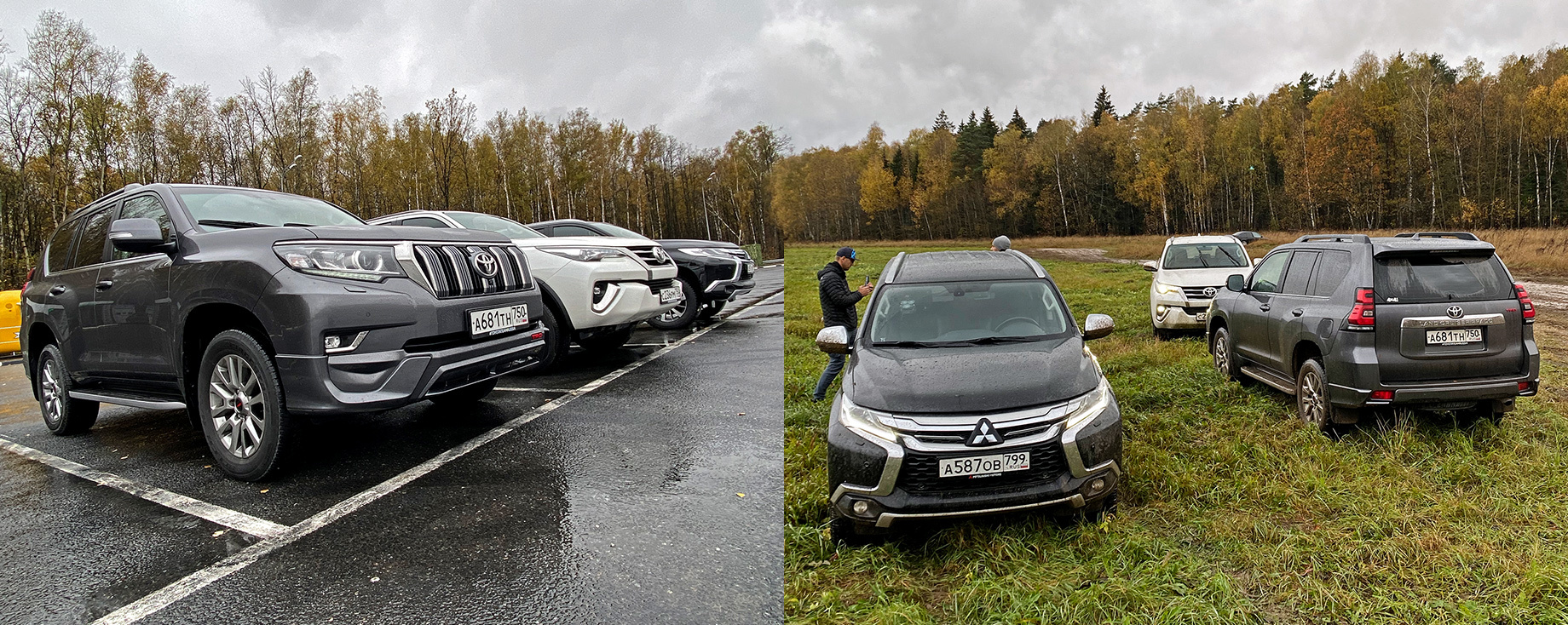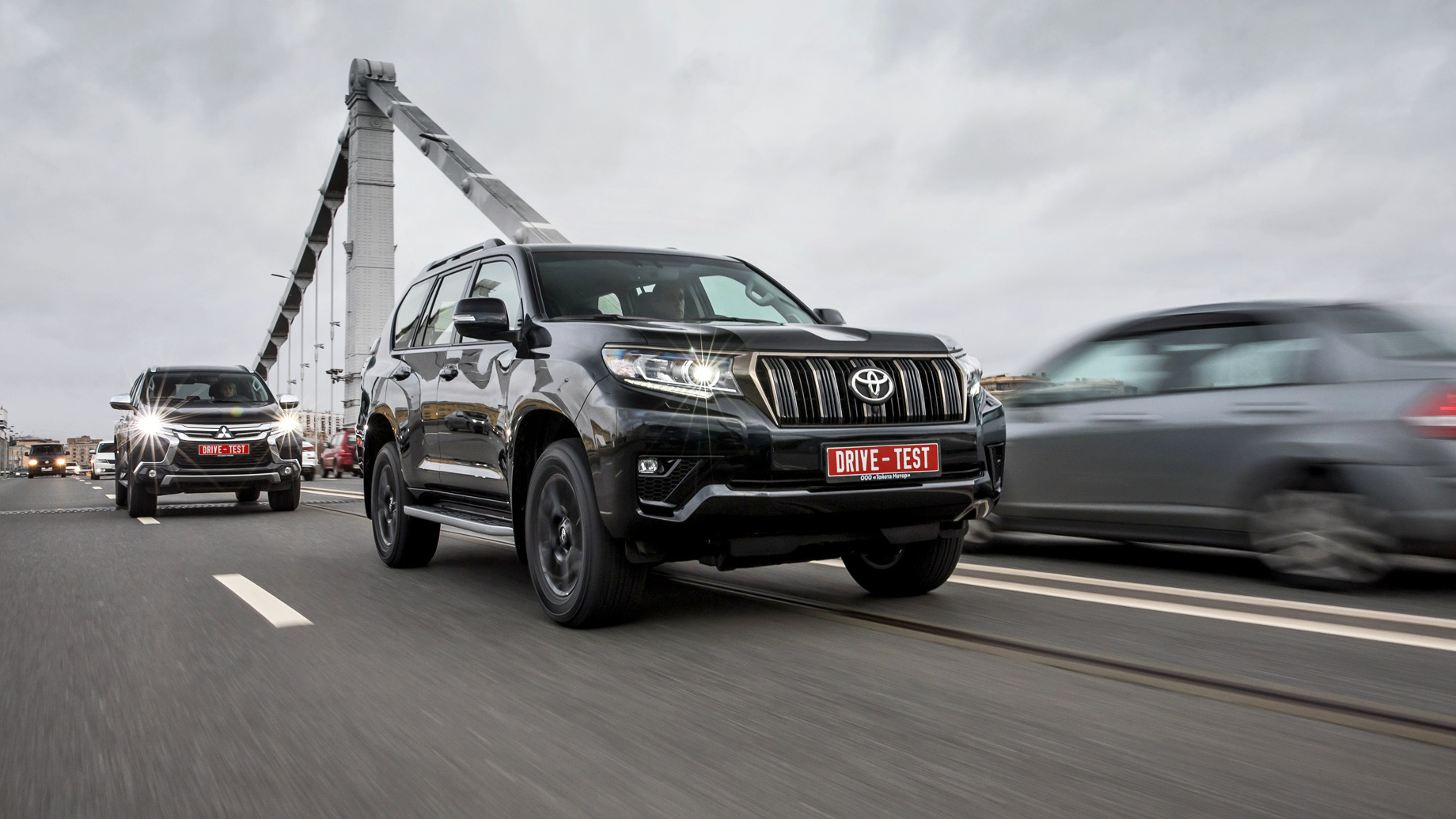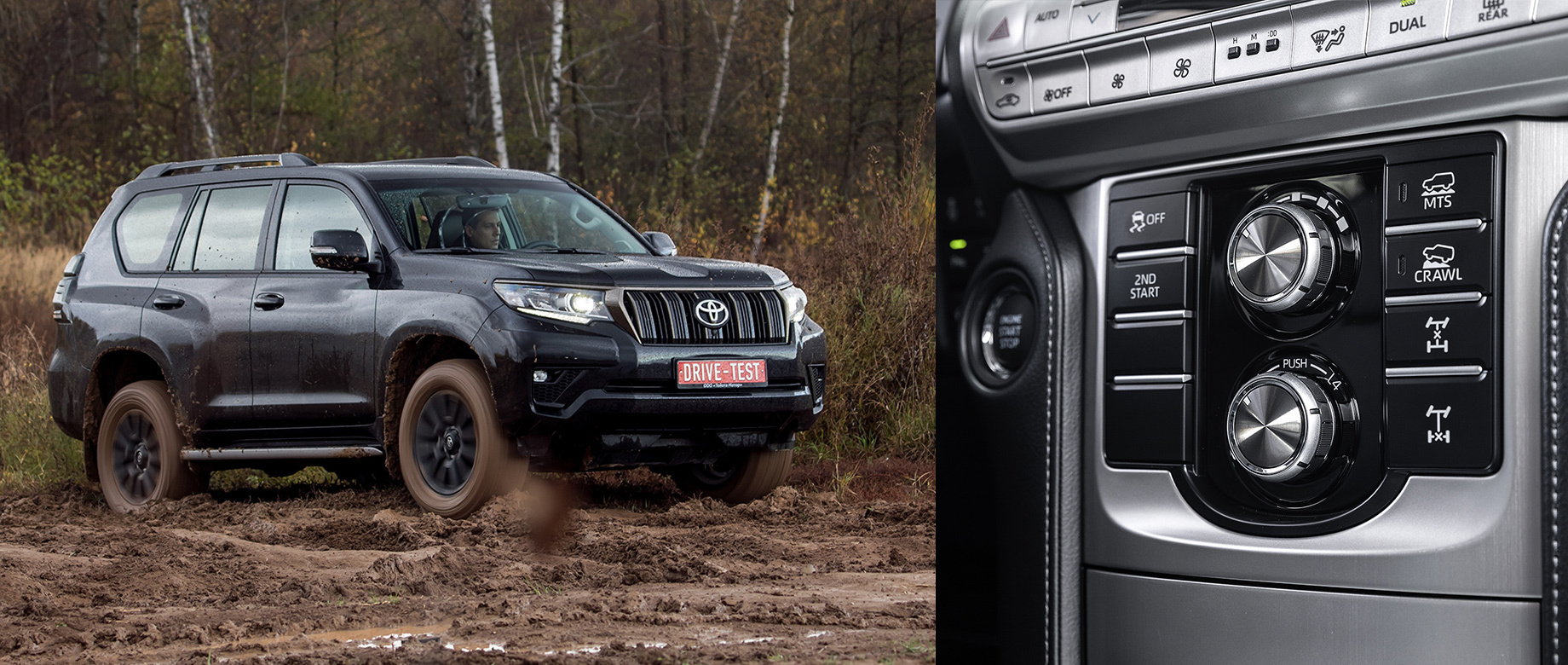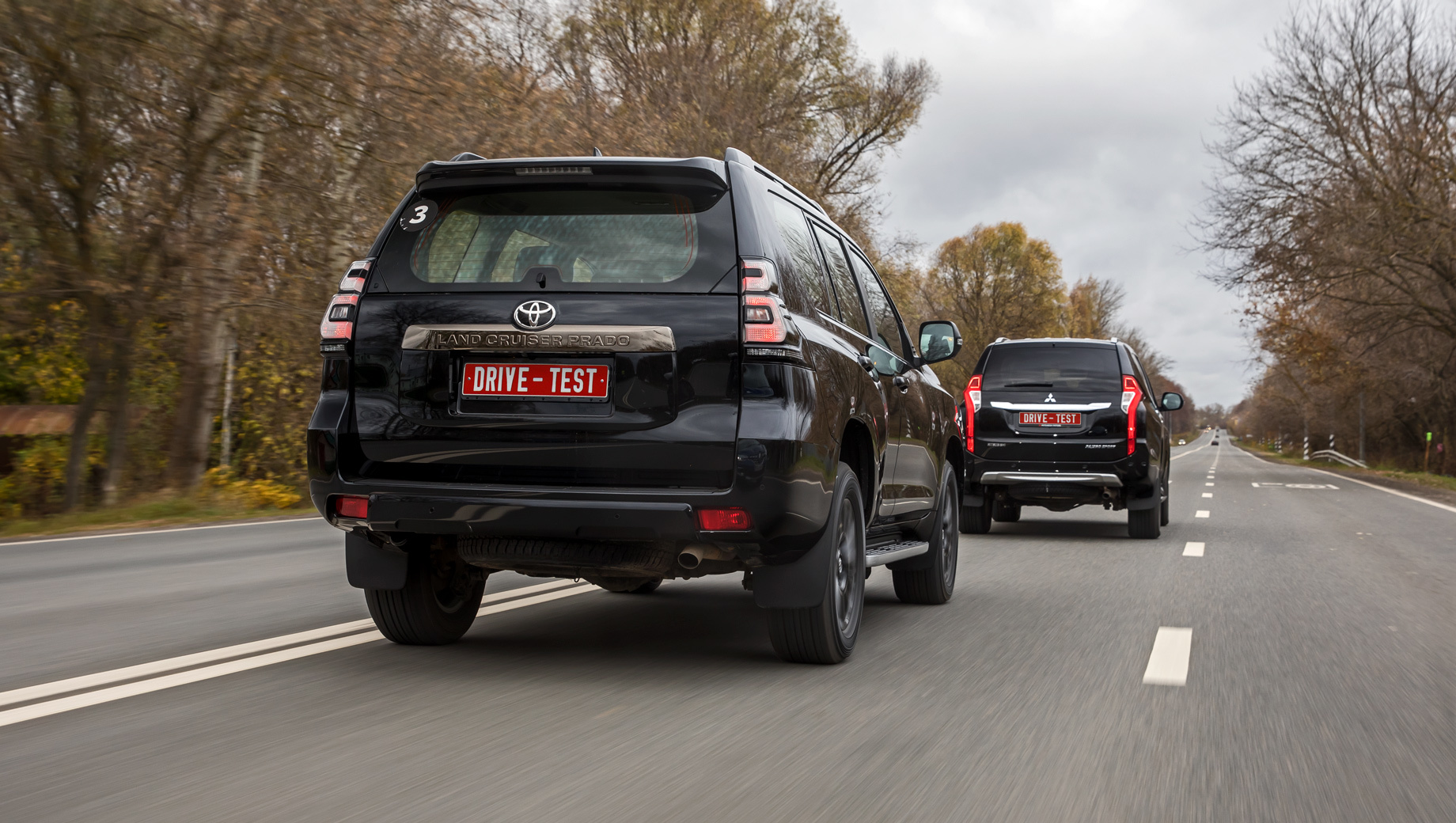Such work can’t be called a full-fledged comparative test. First, I got a Prado with an updated 200 hp 2.8 turbo diesel for just ten hours. Secondly, these body-on-frame SUVs seem to be no longer competitors. Since they clashed epically in our test in 2017, Toyota has brought the Fortuner to the market, as well as the Pajero Sport, created on the basis of a pickup truck. The Prado is thus formally exempt from duels with the comparable in size, but cheaper Mitsubishi.
Nevertheless, the Sport can still be used as a reference car in their notional group. This conclusion came from a preparatory blitz: I prepared the Mitsubishi, as well as both Toyotas, the Prado and the Fortuner, with pre-reform diesels, for the weekend. Despite the incredibly tight response of the 180-hp engine, the Pajero turns out to be the most dynamic according to measurements. It is more intuitively controlled even on Yokohama Geolandar A/T tires which are characterized by noticeable directional troubles. Finally, it provides a smoother ride on a bad road up to a certain speed.

The Prado 2017 is more spacious, quieter, smoother on flat asphalt. Unfortunately, it is equipped with a Kinetic Dynamic Suspension System with hydraulic cylinders in stabilizer links, so it moves rigidly through the bumps. The steering wheel is light and a little empty, but it still has the most information…
The rigid and noisy Fortuner allows you to keep off-road at a higher speed than the springy Pajero, but it shakes your soul just like that. On the earth road, it demonstrates crazy arrogance in contrast to the stubborn Prado. The Fortuner also has the most sensitive accelerator in this company and a couple of rudimentary seats in the trunk equipped with a fifth door servo. The interior design is more joyful, but the working posture is unbearable. The transmission with a rigidly connected front is also a bit simple.
Unsurprisingly, the Fortuner found fewer buyers compared to the Pajero. The Prado is almost twice as successful. The most popular version is 2.8 Prestige. Such is the test car with the notorious KDSS.
Therefore, the Mitsubishi that lingered in the editorial office doesn’t seem superfluous at all at the presentation of the updated 200-horsepower Toyota. It’s the most for context. It emphasizes the advantages of the Prado, and doesn’t allow you to miss the shortcomings. What could be clearer, for example, than parallel starts? Previously, the Prado lagged far behind, and now, at least a little, but it is pulling ahead. It seems like a small increase for a car weighing over 2.3 tons — 23 hp and 50 N-m, but the result exceeds expectations.

With one driver in the cabin and a full 87-liter tank, the Toyota consistently shows 11.1 seconds acceleration to hundred km/h on special roads of test track, despite the resistance of the Dunlop Grandtrek AT22 tires. And its best result is 10.7 s versus 11.5 s for the Mitsubishi. The factory acceleration time of the Prado is not published in all markets. In Germany, where it is simply called the Land Cruiser, and whose nameplate rating is 204 hp at the same 500 N-m, 9.9 s are declared.
For example, in Russia, 12.3 s are declared for the Pajero. On a dry road, using only rear-wheel drive, it is capable of this even with three men in the cabin. In case of humidity, it is necessary to use all-wheel drive mode to avoid slipping. Moreover, the lag from the Prado doesn’t begin immediately, but with a long switch to the second gear after the short first one (4.85:1). Then the ranges change more vividly and the gap almost doesn’t grow.
The Prado is heavier. But, while the Sport has a peak traction point at two and a half thousand revolutions, the Toyota’s four-cylinder 1GD-FTV produces a maximum torque in the range of 1600-2800 rpm — this is almost a third of the entire working area between the idle six hundred and the cutoff at 4300. The LC150 spends less time switching, because there are fewer gears in the box: six versus eight for the Pajero. Although the Mitsubishi changes them more smoothly, except for a jerk when switching to the second.
It’s another thing how the Mitsubishi manages its potential at those moments when maximum output isn’t required. The Pajero extremely reluctantly converts the movement of the gas pedal into acceleration, which makes it seem heavy, and the SUV is sleepy. Revolutions rise slowly. There are no tools to cheer up the car, except to push the pedal with all might. The Prado is more responsive. The accelerator connection is more linear, but even here it remains insufficiently rigid at partial loads. The engine responds somewhere from the accelerator half-stroke, and the torque converter of the automatic gearbox is in a state of uncertainty.

The main thing is that the Prado with a new engine has become subjectively more dynamic than the previous one. It has become easier to move in urban traffic and overtake on the highway. It didn’t seem to me that the 200-hp turbodiesel is quieter than before or vibrates less at idle, as colleagues tell me. To check this, you need to move from one Toyota to another.
Against the background of the noisy and vibro-loaded Pajero engine, everything is the same. But perhaps, I don’t notice the difference due to distinctions of the specifications of the two test Prados and the effect of different tires on the overall acoustic balance. The pre-reform one was shod in a more asphalt Bridgestone Dueler H/T. The new one was specially taken on Grandtrek to equalize the chances off-road.
By and large, it doesn’t make much sense to climb into the sticky clay after our colleague, an off-road lover, on the Mitsubishi. But when else will there be a chance to wade through dirt on such a skilled high-mobility vehicle as the Prado? It is necessary to remind yourself why people with imagination buy such cars. The aforementioned colleague and Super Select II are certainly a strong combination. But I also have at my disposal a granny gear with a couple of locks, plus traction superiority and multi-program traction control with a very effective crawl mode.
Alas, after a few rainy days, the conditions are such that there is no benefit from the assisting electronics. The rear differential lock remains unused in order to maneuver more freely. While uphills and trenches are stormed only by riding. And here the harsh Toyota is good because it swings less, simplifying the vital control of weight distribution. In deep ruts, you only outline the direction with a steering wheel and control the car mainly by traction. I’ve been through enough until I remembered how it is done in general.

Sport, not the Pajero with a cable, but the Sport mode of the power unit, helps out a lot here. This is the most important program in the life of a wealthy fisherman or hunter. The urban smoothness of responses to the fuel supply is harmful in such a swamp: before you push the pedal, and the Prado wakes up, it will almost get stuck. And sometimes it’s enough to lose pulse even for a moment to get into a jam. The Mitsubishi is partly saved by the honest manual mode of the automatic transmission, partly by the most aggressive algorithm of fast traction control.
Contrary to my fears, I drive even where the colleague asks me not to go – however, at the cost of a license plate torn out “by the root” by a stream of water. The colleague happily waves his catch, pronouncing his “all right”… Now is the time to temper his expedition fire and turn the car towards the house before we need a tractor or, rather, an APC. Both the editors and our photographers know that a rare such outing ends before dark.
I don’t have as rich a history of relationships with the LC150 as a colleague does. After all, he drove far and wide even in a little-seen Prado with a mechanic gearbox. But in general, a brief acquaintance with the model line of Toyota SUVs is enough to agree: a modernization of the 2.8 turbodiesel will benefit them.
Calling a spade a spade, the Prado was a vegetable before the update. We know plenty of owners whose only argument against is the lack of dynamics. Tellingly, a diesel 177-horsepower Toyota is often changed to a gasoline one with V6 4.0 (249 hp). Such versions are traditionally a little cheaper, and this time there were multimedia updates only.

The Prado still seems a little overrated to me. All its advantages like a more spacious and functional interior, acoustic comfort, and now the convenience of acceleration control are not enough to justify the huge difference in cost between the test cars. However, if you put the uncouth Fortuner, which costs like the Pajero Sport, next to the Prado, it’s not a pity to pay such an amount here. So the LC150, in a sense, turns out to be a hostage to the intermediate model price formation.
Don’t forget that an updated Mitsubishi has recently appeared. Its interior is slightly enlivened by a digital dashboard, an upgraded multimedia complex (control, alas, remains touch-sensitive) and a climate unit with temperature control knobs instead of buttons. The electromechanical parking brake finally got the Auto Hold function, and the fifth door – an electric drive with a motion sensor. I assume that the prices for the localized Pajero Sport will rise slightly. I don’t know if the Fortuner 2.8 will rise in price next. But any price boost of these cars will inevitably benefit the Prado.
This is a translation. You can read the original here: https://www.drive.ru/test-drive/toyota/5f92af16ec05c46063000254.html

Published July 28, 2022 • 7m to read






